Affiliate links on Android Authority may earn us a commission. Learn more.
Anandtech's Snapdragon 810 preview: no overheating issues spotted
Published onFebruary 13, 2015
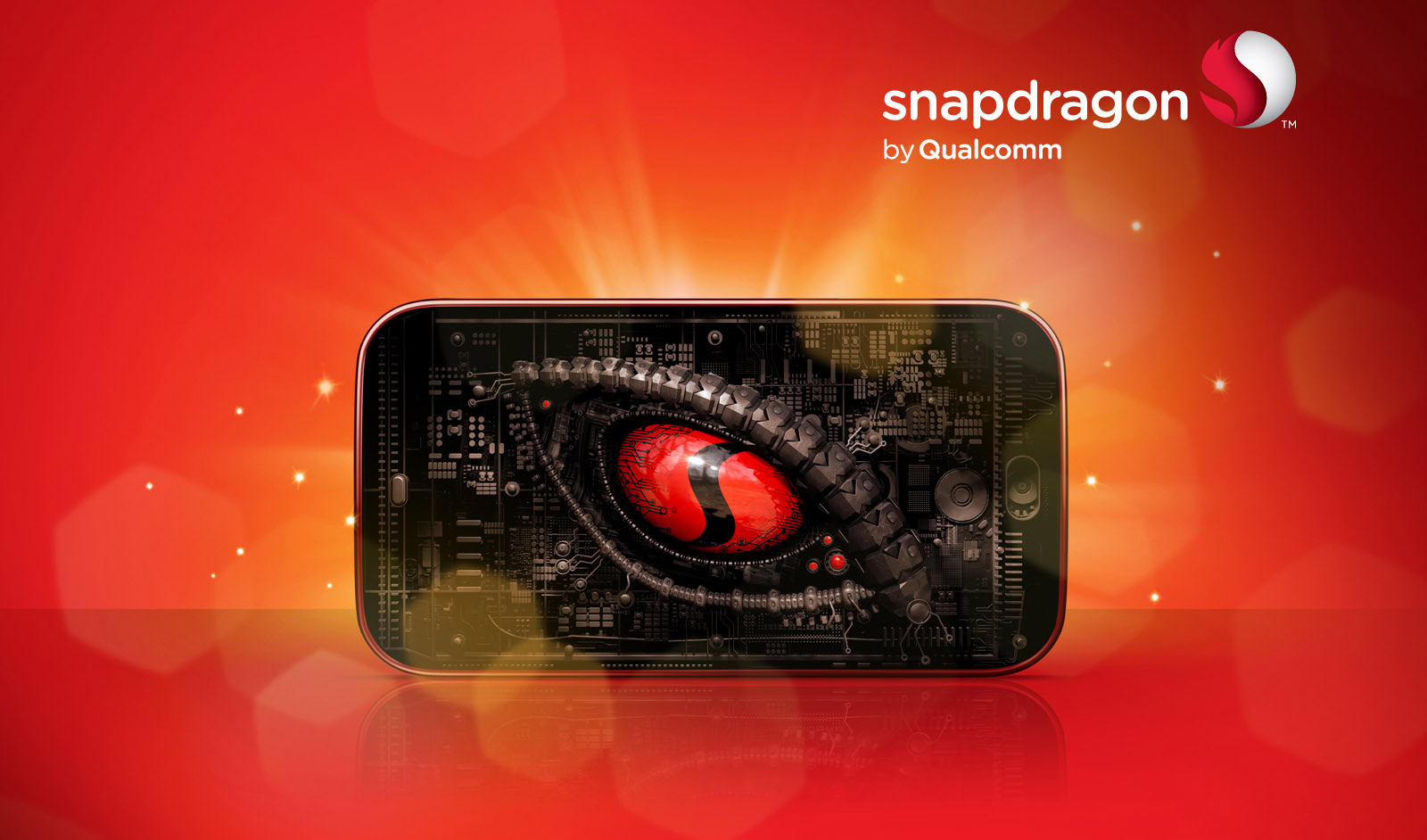
The launch run up for Qualcomm’s new flagship Snapdragon 810 mobile SoC has been plagued with rumors and speculation regarding performance and overheating issues, despite numerous rebuttals from Qualcomm and mobile manufacturers partners. Fortunately, AnandTech has put Qualcomm’s latest high-end chip through its paces, giving us the closest look yet at what sort of performance we can actually expect from the Snapdragon 810.
For a quick recap before we delve into some of the most interesting results, the Snapdragon 810 is Qualcomm’s first ARM Cortex-A57 and A53, big.LITTLE based SoC and the first 800 series chip to depart from the company’s custom Krait CPU design. The SoC’s CPU is a closer match to Samsung’s Exynos 5433, however there are some big differences in the broader SoC design, and not just limited to the use of Qualcomm’s new high-end Adreno 430 GPU and LPDDR4 memory. Qualcomm is also making the move to TSMC’s 20nm manufacturing process, bringing with it additional energy efficiencies.
See the spec table below for a quick comparison.
| SoC | Snapdragon 810 | Snapdragon 805 | Exynos 5433 |
|---|---|---|---|
| SoC CPU | Snapdragon 810 4x Cortex A53@1.56GHz 4x Cortex A57 r1p1 @1.96GHz 2MB L2 cache | Snapdragon 805 4x Krait 450@2.65GHz 4x512KB L2 cache | Exynos 5433 4x Cortex A53 r0p1@1.3GHz 512KB L2 cache 4x Cortex A57 r1p0 @1.9GHz 2MB L2 cache |
| SoC Memory | Snapdragon 810 2x 32-bit @ 1555MHz LPDDR4 24.8GB/s b/w | Snapdragon 805 4x 32-bit @ 800MHz LPDDR3 25.6GB/s b/w | Exynos 5433 2x 32-bit @ 825MHz LPDDR3 13.2GB/s b/w |
| SoC GPU | Snapdragon 810 Adreno 430 @ 600MHz | Snapdragon 805 Adreno 420 @ 600MHz | Exynos 5433 Mali T760MP6 @ 700MHz |
| SoC Process | Snapdragon 810 TSMC 20nm SoC | Snapdragon 805 TSMC 28nm HPm | Exynos 5433 Samsung 20nm HKMG |
CPU & Memory
We’ll start with the CPU results, the component at the center of the performance and overheating rumors. AnandTech ran a series of benchmarks using the Qualcomm Snapdragon 810 Mobile Development Platform (MDP) tablet. In summary, performance can vary somewhat depending on the test, but overall the Snapdragon 810 makes its way towards the top of most of the results. GeekBench 3 results show roughly a 30 percent increase in performance over the Snapdragon 805 and similar performance to Samsung’s Exynos 5433, as you would expect.
However, the Snapdragon 810 CPU seemed to struggled in the WebXPRT test, with performance ending up somewhere around the level of the much older Snapdragon 801 and far behind the Exynos 5433. Worryingly, AnandTech was unable to run the test multiple times to double check the result and suggests that some thermal throttling or other issues could still be present.
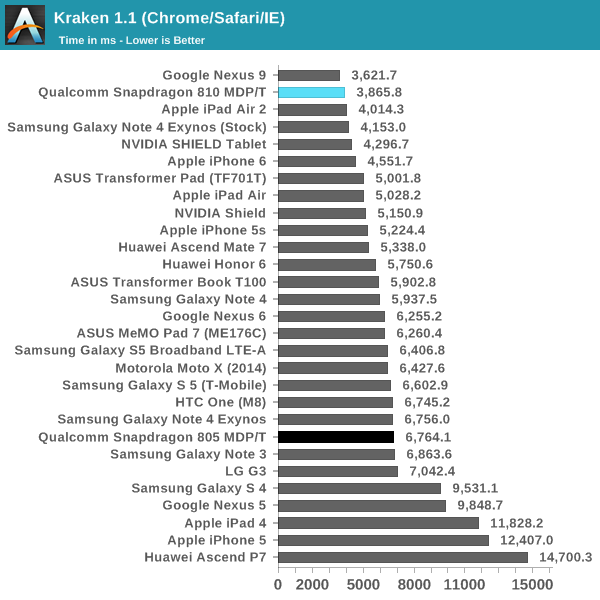
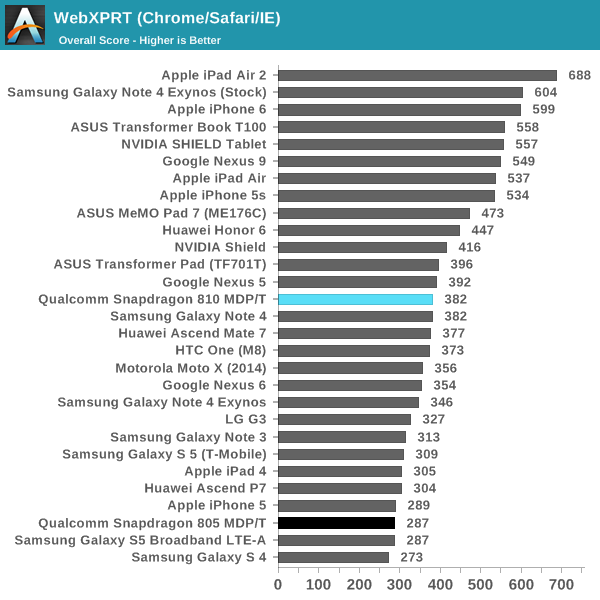
Oddly, the Snapdragon 810 also shows some poor results when the SoC’s memory is put through its paces. Performance shows no real gains over the Snapdragon 805 or Exynos 5433, despite the supposedly higher bandwidth available. Instead, the available bandwidth appears similar to many existing products, while the memory latency test falls far behind expectations. This could account for some of the other CPU test result anomalies, and we will have to wait and see if this problem persists in consumer grade products.
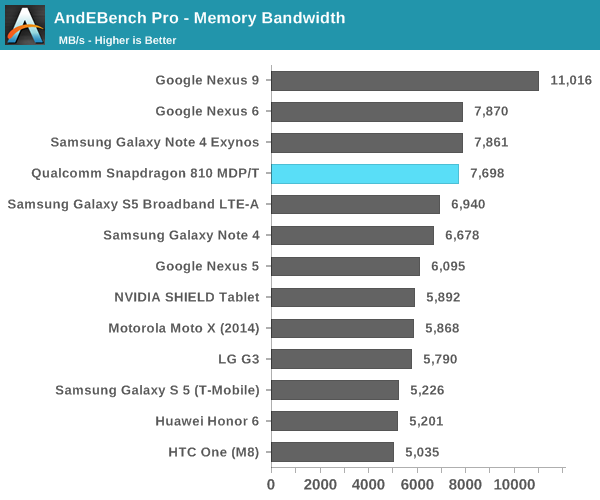
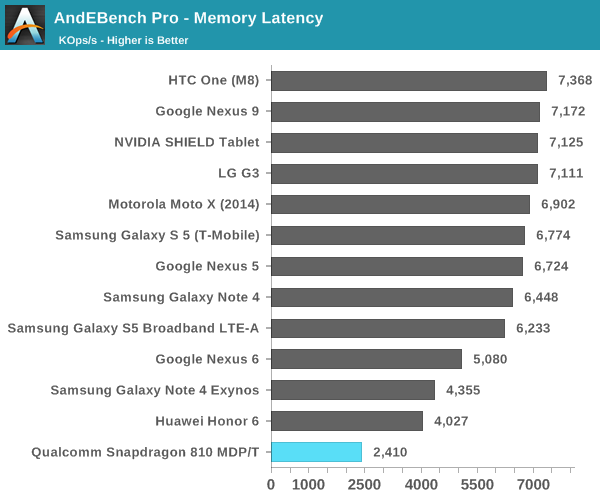
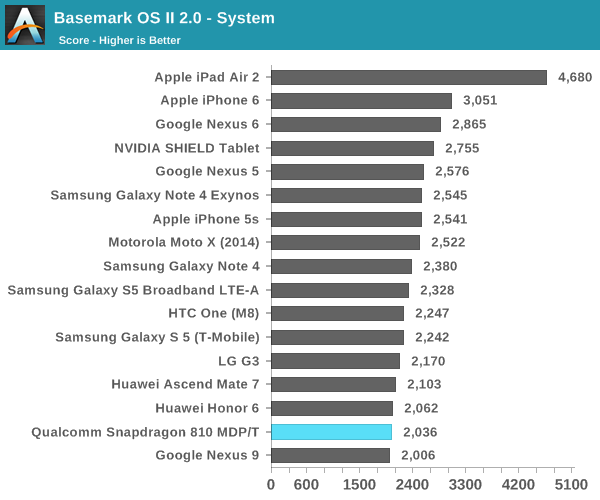
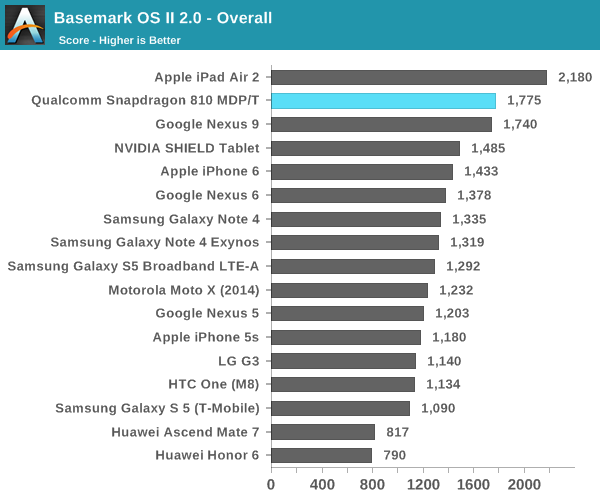
One interesting difference between Qualcomm and Samsung’s implementation of the ARM Cortex-A57 and A53 big.LITTLE core arrangement is power and task scheduling, which is important for efficiently delegating tasks between the eight CPU cores. Samsung has implemented the ARM and Linaro developed Global Task Scheduling, while Qualcomm has opted for its own window-based system instead. There’s a lot more about the specifics in the original article, but the takeaway is that Qualcomm’s solution is superior overall and could help level the performance and energy differences as Samsung moves to an even smaller manufacturing process, even though it does have its own drawbacks. Some of these gains come from specific optimizations made for Qualcomm’s chip, while ARM’s reference scheduler has to work with a wider range of core options.
Despite falling short in some tests, the Snapdragon 810 offers up noticeable CPU performance improvements from the previous 805 and 801 generation, but the SoC is not going to leap miles ahead of competing chips on the market. Fortunately, there doesn’t appear to be any obvious issues with heat or performance, but there is clearly room for further optimizations come final grade consumer devices.
GPU
Qualcomm is also throwing in its latest and greatest Adreno GPU into the Snapdragon 810. The Adreno 430 promises a 30 percent increase in performance over the Snapdragon 805’s Ardeno 420, despite both clocking in at 600 MHz each.
The first selection of 3DMark 1.2 results show that the Adreno 430 is capable of even greater performance improvements, showing up to a 65 percent increase in performance and coming in right behind the Google Nexus 9’s impressive NVIDIA Tegra K1 Kepler GPU. However, physics performance comes in considerably behind older Snapdragon based devices, which may have something to do with the hit and miss CPU performance detailed earlier.
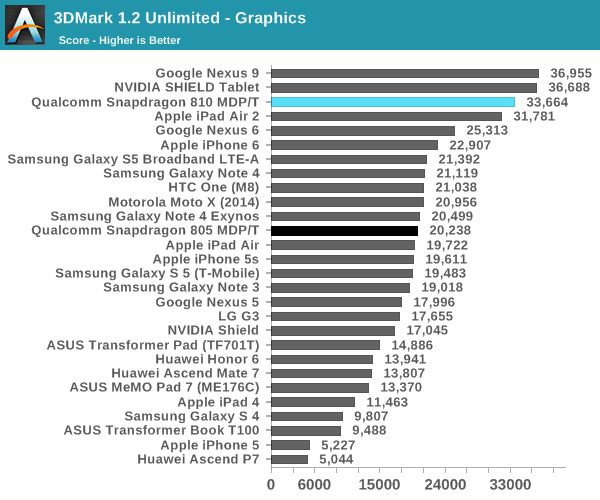
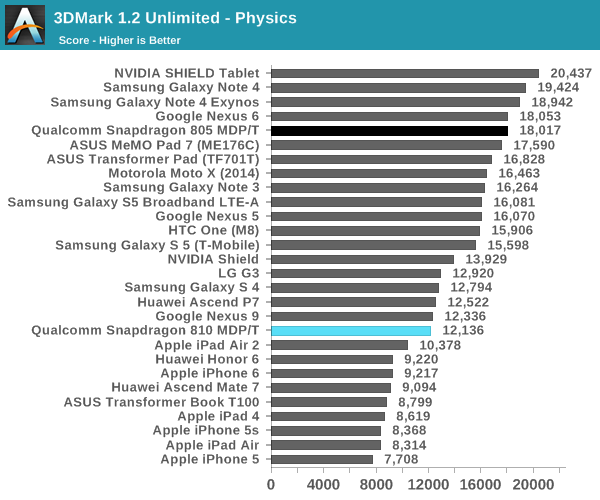
“Offscreen” tests give us a more independent look at how GPU’s compare with one another, and the Snapdragon 810 manages a 33 percent improvement over the 805 in Manhattan and 16 percent in T-Rex benchmarks, and boast similar gains over the Exynos 5433’s Mali T-760 GPU.
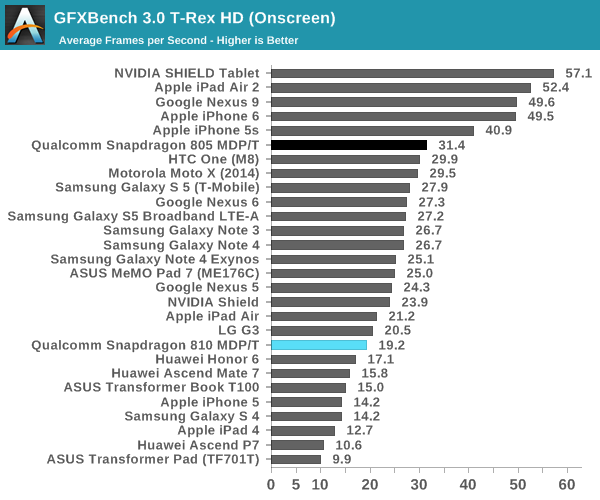
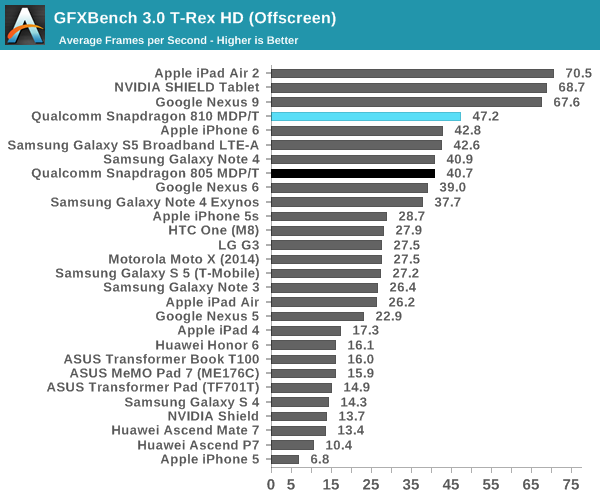
AnandTech also tested a range of GPU attributes to identify where performance improvements had been made between the Adreno 430 and 420. The result found that ALU performance was up 46 percent and shader focused based tasks showed around a 30 percent performance improvement, while other GPU elements showed no significant performance improvements.
Overall then, the Snapdragon 810’s Adreno 430 GPU looks to offer a significant performance improvement over last generation SoCs, and is probably the chip’s biggest area of improvement. However, real world performance is likely to depend on the type of workload, with some scenarios possibly showing little improvement over the Adreno 420. As expected, smooth 4K performance is still off the table this generation.
Both CPU and GPU performance looks to be in-line with what is expected from the 810’s technology, although memory issues and hit and miss CPU results are somewhat worrisome. The chip likely won’t be as far ahead as the competition as previous high-end Qualcomm SoCs, but Qualcomm’s leading integrated modem technology is still likely to make it the company of choice for most mobile manufacturers. Fortunately, rumored major overheating issues do not appear to have manifested in the (almost) finished product.